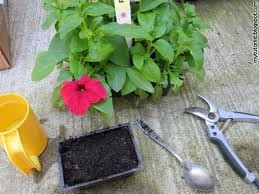Double petunias are generous flowers that have twice the number of blossoms as a single petunia, which cover the entire plant head. The flower forms resemble carnations. The first double petunia came out of Japan in 1934. Today these hybrid plants come in pink, blue, lavender, purple, red, lilac, white and bi-colors; they have been developed to be as hardy and versatile as single petunias. Plant double petunias in planters, hanging baskets or in your flower bed. You can start them from seed or buy transplants from a nursery. Multiflora, Grandiflora and Floribunda are examples of classes of double petunias.
Difficulty: Moderately Easy
Instructions
Things You’ll Need:
- Double petunia seeds (or transplants)
- Tray
- Potting soil
- Sphagnum moss
- Clear plastic sheet
- Pots (2 1/4-inch)
- Fertilizer
- Compost
- Mulch
- Garden rake
-
Purchase double petunia seeds from a local nursery. Ask the staff if they have an instruction sheet for the particular variety of double petunia you will be planting. The sheet may specify the type and amount of fertilizer to apply, specific to your area.
-
Start seeds indoors 12 weeks before the last frost date. Fill a tray or shallow container with damp potting soil and/or ground sphagnum moss. Spread seeds on the surface of the soil and press on them lightly. Do not bury the seeds. Mist them with water. Place a clear plastic sheet on top to create a greenhouse effect. Place the tray in a location that receives indirect sunlight and has a temperature between 70 and 75 degrees Fahrenheit.
-
Remove the plastic sheet once the seeds have begun to germinate. Move the tray to a bright spot that receives temperatures between 55 and 65 degrees Fahrenheit. Water as needed so that the soil remains moist, but not water logged.
-
Transplant the germinations each to their own 2 1/4-inch pot with potting soil and liquid fertilizer when the plants have developed their first true leaves (cotyledons). Keep these pots in the same space as the tray was in. On warm, sunny days, place the pots outside to help them adapt to outdoor conditions. Bring them back inside as the day cools.
-
Prepare your garden by removing weeds, roots and other debris from the soil. Select a spot that receives full sun, unless you live in a southern region that has extremely hot days. In this case, select a spot that receives partial shade. Work compost into 2 inches of the soil.
-
Plant your double petunia transplants after the last frost date when the average soil temperature is 60 degrees Fahrenheit. Plant transplants 10 to 12 inches apart. Add the recommended fertilizer every two to three weeks. Water so that the soil remains moist, unless you receive enough rainfall. Surround plants with mulch to prevent weed growth, maintain moisture and to keep the blossoms free of mud.
-
Dead head (remove) blossoms that have wilted or turned brown. Prune varieties like multifloras and grandifloras, once they have grown 6 inches high, to encourage new growth.


Deprecated: strpos(): Passing null to parameter #1 ($haystack) of type string is deprecated in /home/agriviek8Qv/agriviet.net/public_html/wp-includes/comment-template.php on line 2522